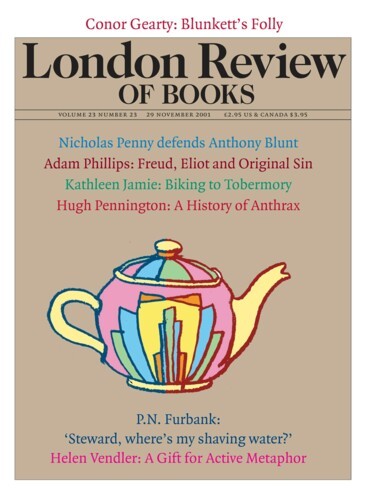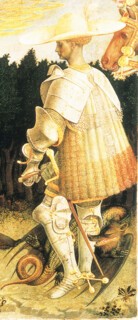Pisanello, the subject of an exhibition which can be seen until 13 January at the National Gallery, was admired above any of his contemporaries in the 15th-century Italian Courts, and much praised and patronised. He was, by any definition, fashionable, a man who both made and recorded fashionable things. The exhibition includes a remarkable proportion of his surviving work: the drawings document the efforts of embroiderers, tailors, furriers, hatters, armourers, hawkers, huntsmen, dog breeders, harness makers and horse copers – the makers or minders of gear for the princely pastimes of choice. There are even a few bits of real armour which show how accurate he was. The princes themselves are here, too: in portraits on medals and in paintings of Leonello d’Este and (probably) his wife Margherita Gonzaga, a picture which is, we’re told, the first Italian profile portrait of a woman. She sits composedly, if not exactly decorously (there is, in her look, a suggestion of the cheerful, self-willed schoolgirl) in front of a background of dark foliage dotted with pinks, columbines and butterflies. There are preparatory drawings for scenes of romantic chivalry: one of the now sadly battered frescos in the series illustrating Arthurian legends which he painted in the Palazzo Ducale in Mantua has been blown up as a wall covering. Even his St George (shown here), who wears a broad-brimmed straw hat and fine armour, and his St Eustace, in a fur-edged gold coat, are dressed in high fashion.
The portrait medals, ten centimetres or so in diameter and cast in bronze or lead, belong to a genre which he invented. On the obverse, the face of an Italian mercenary can be given the gravitas of an emperor on an ancient coin – and still be dressed in the height of fashion. Emblems on the reverse – an elephant, a blindfolded lynx, a virgin with tamed unicorn, a child-faced Janus looking left, right and forward, flanked by the knee-pieces of a suit of armour – gloss the portraits, sometimes simply (the virgin and unicorn are on the reverse of Cecilia Gonzaga’s) but in the case of the Leonello d’Este medals so obscurely that only two have been satisfactorily explained. These medals, the smallest pieces in the exhibition, are also in a way the grandest. Because they are modelled and cast, not engraved and struck, they are larger and more broadly handled than the coins they imitate. Later medals were to be more exquisitely crafted but Pisanello’s profit from a forced simplicity. His painted portraits in profile are a stage in the progression from hieratic to realistic representation – three-quarter and full-face images will very soon take over. On medals, however, profiles come naturally; Pisanello’s have, despite their size, a monumental assurance.
How far can one understand the effect these things had when they were new? Their innocence and sweetness reflect not life as it was, but life as you might dream it. The quotation from Bartolomeo Facio’s biography of 1456, which is printed on one of the gallery walls and in the catalogue heads the chapter on the panel paintings (only two survive, both in the National Gallery’s own collection: The Vision of St Eustace and The Virgin and Child with Sts Anthony Abbot and George), suggests the charm of his pictures better than any modern commentary: ‘The Pisano of Verona has been ascribed almost a poet’s talent for painting the forms of things and representing feelings. But in painting horses and other animals he has, in the opinion of experts, surpassed all others.’
The painted flowers and studies of animals indeed have the freshness of things properly seen for the first time. There are note-like sketches – the one of hanged men, for example, or the drawings of the entourage of John VIII Palaeologus, the Byzantine Emperor, made when he was attending the Council of Ferrara in 1438 – but it is the worked-up studies which best meet Facio’s description: of a horse harness drawn as though to instruct a farrier, and the different qualities of the long hairs round a horse’s nostrils, the coarse matted coat of a boar, the fur of a hare, the smooth coat of a hound, each hatched and shaded hair by hair. These are loaded with redundant information, but the swifter methods of notation which were to follow, combining greater confidence about structure with more economical ways of representing (and distinguishing) the soft, the glossy and the hairy, lost some of Pisanello’s intensity. Sometimes his attempts to show human feelings (for example, the grimaces of the figures below the hanged men on a gibbet in the fresco of St George and the Princess of Silena) seem caricature-like when compared with the more subtle expressions which later, perhaps less honest, physiognomical conventions would produce. The animals, both drawn and painted, have the charm of difficult things still not perfectly realised within a single convention: the many horses seen from behind are set pieces of foreshortening in which a stereotype still infects an observed pose, and closely observed birds and animals are spread as tapestry-like decorations over a background which fails to recede.
One may doubt whether E.H. Gombrich, who died on 3 November, ever passionately liked, or was even very curious about, individual paintings, except in so far as they could illustrate the deeper matters on which he was so illuminating, in particular what goes on when people make marks which other people are able to interpret as representations of things. For these purposes, a cartoon, an optical illusion or a significantly bad painting could be more to the point than a masterpiece. By bringing the researches of psychologists to art history and analytic severity to statements by artists, as well as by critics and historians, about what pictures do, he cleansed many corners of the stable. Here is what he wrote in his Story of Art about a sheet of drawings of a monkey:
a drawing made by the North Italian artist Pisanello (1397?-1450) only some twenty years after the Limbourg miniatures shows how this habit [of supplying detail in things like manuscript illustrations] led artists to study animals with loving interest. The public which looked at the artist’s works began to judge them by the skill with which nature was portrayed and by the wealth of attractive details which the artist managed to bring into his pictures. The artists, however, wanted to go one better. They were no longer content with the newly acquired mastery of painting such details as flowers or animals from nature; they wanted to explore the laws of vision, and to acquire sufficient knowledge of the human body to build it up in their statues and pictures as the Greeks had done. Once their interest took this turn, medieval art was really at an end.
Pisanello’s odd combination of elegance and gawkiness is thus explained as the result of a move towards representations which say more about the look of things. Views from odd angles (a horse or a hawk from behind, a man lying on his back) are incompatible with decorative and harmonious order. Painting was giving up a little dignity in order that it might surprise more.
For many of us who grew up with Gombrich’s work his account of the significance of changes in the practice of Western painting can’t be avoided – it must be met with argument if you can’t accept it. More generally, he showed, with an astringency which is always in short supply in writing about art, that some things can be said, and others can’t, if its study is to have objective validity.
Send Letters To:
The Editor
London Review of Books,
28 Little Russell Street
London, WC1A 2HN
letters@lrb.co.uk
Please include name, address, and a telephone number.


